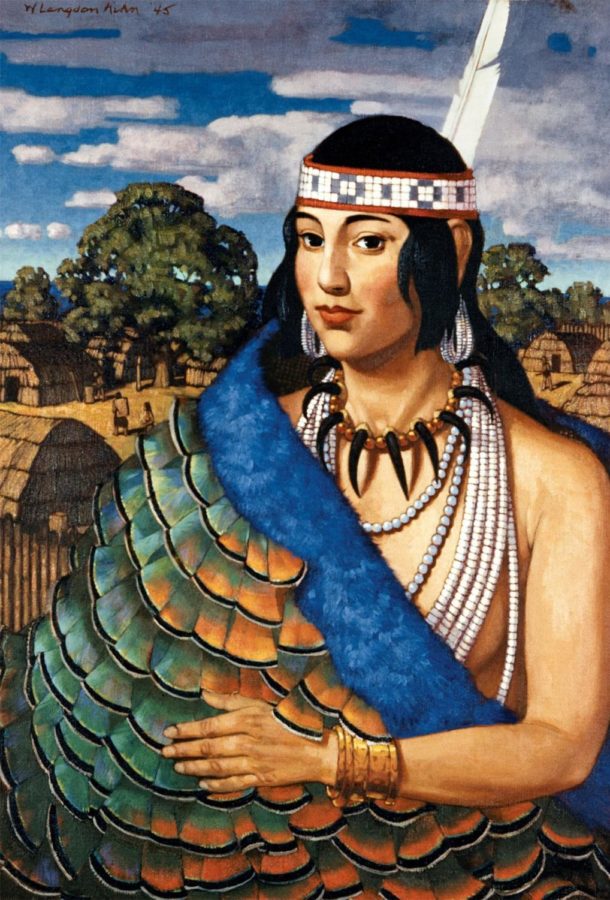A Lady Shrouded in Myths
Everyone knows Lady Rebecca Rolfe, the Disney character who sings “Colors of the Wind” in the beloved 1995 Disney movie. If not, surely “Pocahontas” rings a bell? Lady Rolfe’s nickname was actually “Pocahontas,” but when she was born, according to The Indigenous Foundation, she was known as Amonute or privately, Matoaka, the “flower between two streams.” As one of the first Murdered & Missing Indigenous Women (MMIW), her story holds a controversial position in the hearts of both her tribe and the American people.
Born in 1596, Matoaka was the favorite child of Wahunsenaca (Chief Powhatan), the chief of the entire Powhatan Chiefdom. According to The National Park Service, her father ruled over 30 tribes, and they all lived peacefully in the area later known as Jamestown, Virginia. Little Amonute lived peacefully, and she spent her days productively: farming, cooking, weaving, and more. Unfortunately for the Powhatan tribe, the peace was short-lived. Her Disney Prince Charming, John Smith, arrived with an onslaught of Englishmen. In 1607, he was 27 while Amonute was 11. Despite the fact that the English constantly sexually assaulted the indigenous girls, Pocahontas still saved Smith from an untimely death. Although each of Smith’s accounts of this differ, she supposedly prevented his head from being smashed between two rocks, and after her interference, Wahunsenaca amicably acknowledged him as “son.” Over the following months, when negotiations soured, Amonute purportedly risked her life to inform Smith before an assassination attempt. Fortunately for historians, Smith had a way with words, and his biographies were irrefutable; he published his works so late that no one could deny his truthfulness.
One time, Amonute did marry for love. At age 16, she chose Kocoum, the brother of Chief Japazaw, as her husband, and the two would have a baby together. Her father hoped that Kocoum’s tribe would be strong enough to protect Amonute, but her brother-in-law ultimately stabbed her in the back during the First Anglo-Powhatan War. Japazaw saw how powerful the English were with their stashes of rifles and swords, so when the English requested Amonute, he willingly handed her over to English Captain Argall. In exchange, Japazaw received a copper kettle to console Amonute’s father. At the same time the girl boarded the ship, her husband was murdered without her knowledge. Luckily, her son lived. Amonute was a valuable bargaining chip, so over time, the English tried, again and again, to leech ransom off of her father.
The thirteen colonies were blessed, but for the Native girl, tragedy ensued. She was a beautiful young hostage, so men raped her, forcing her to quarantine in Henricus under the surveillance of minister Alexander Whitaker. Alexander taught her Christianity, culture, and English so that she could become the model for a “good Indian” at the cost of her identity. Christianity was the key to John Rolfe’s heart. Once she was baptized as “Rebecca,” the lady married John Rolfe, a widower and tobacco planter, due to both romantic and political interests. In 1616, the supportive wife went around with her husband during a propaganda campaign to show the world that the “heathen tribes” were not beyond salvation. She passed away at the age of 21. Wahunsenaca requested a tribal burial, but Rolfe and Captain Argall took the initiative to bury her in Gravesend, England. Utterly inconsolable, the Chief passed away a year later.
“Pocahontas” is a story that the general audience would prefer to hear because the English are portrayed as the saviors, not the oppressors, of the Natives. As mentioned by The Smithsonian, the story justifies colonial imperialism, and it justifies the misdemeanors the Natives faced time and time again at the hands of privileged individuals. As painful as it may be to hear the truth, sharing her true story might prevent unfortunate aspects of history from repeating itself. On the bright side, Native children today appreciate being able to identify with a titular character of a well-received movie. Without a doubt, “Pocahontas” is a stunning woman, and through the Disney movie, she directs the spotlight to the Native cause. She is the icing that entices the audience to see what lies beneath the flowery surface. For that reason, do not be ashamed to“paint with all the colors of the wind” and see the inherent beauty in all forms of life.


